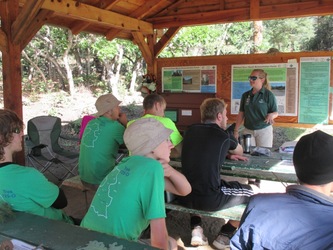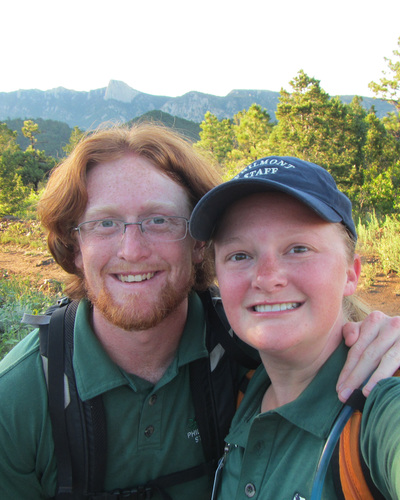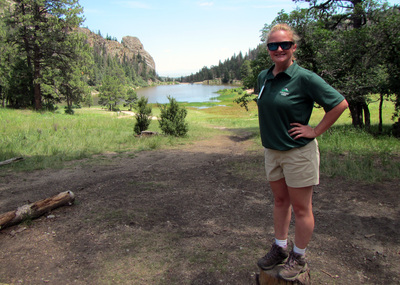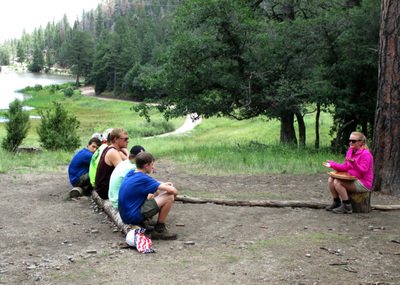 I've just returned from my trip to Philmont Scout Ranch as a Visiting Forester and the experience was fantastic. I am so glad I decided to go back to a place I love and teach the scouts about fire ecology, forestry, and the complexity of forest ecosystems. Located in northeast New Mexico, Philmont is a magical place for scouts to experience near-wilderness and learn the true meaning of "team" as they embark on twelve day backpacking treks of 50 miles or more. The Scouts must carry all their food (four days worth at a time) and supplies, including water and shelter. In addition, theymust work together to set up camp, ensure bear safety procedures are followed, cook meals, and navigate. While there are two or more adult leaders present, they are strongly encouraged to let the scouts do all the work, make mistakes, and work through the mistakes to ensure the crew arrives at each camp safely. Philmont is a life-changing experience that I was lucky enough to take part in twice as a scout; in 2004 and 2006.  I was one of many Visiting Foresters this summer and taught approximately 800 scouts and advisers about the forested ecosystem they were hiking through, a ponderosa pine/mixed conifer forest. The main forest issue we discussed was the overly-dense forest conditions due to the loss of its natural fire rotation. The exclusion of fire from this fire-dependent ecosystem was mainly due to agricultural needs (grazing livestock) of the late 1800's and fire suppression of the early to mid 1900's.
I recommend this opportunity to any practicing forester who is interested in giving back to the youth, the land, and/or the scouts. You'll teach scouts, advisers, Philmont staff, and more while staying in the back country for a week. You might even help a youth or college student learn about the great industry of natural resources management or in my case, the cooperative Extension service. Additionally, if you are a company, consultant, or other forest-product industry professional interested in helping Philmont thin, please feel free to contact me and I'll help get you in contact with the forest managers out there. Interested in the details of this program including our education topics and conservation efforts? Click "Read More" in the bottom right-hand corner.  We helped the scouts learn to identify the species of interest: ponderosa pine, white fir, douglas fir, rocky mountain juniper; understand the degree to which the forest is overstocked; and what solutions exist to help prevent a catastrophic wildfire in the area. In case you are wondering, we need to incorporate aggressive forest management techniques to reduce the density of ladder fuels and remove downed woody debris, aka fuel. To help with this need for active, manual removal of ladder fuels and down woody debris, we engaged the scouts in some conservation work (a requirement of all crews on the trail). At our location, we instructed scouts working on their conservation project to remove small white fir trees and preform the "lop and scatter" method of felling. In this method, they took small white fir trees and cut them as close to the ground as possible and then removed and scattered any limbs that stuck up off the ground more than six inches. This method of felling helps return nutrients to the soil and also reduce standing ladder fuels.
Patrick McGough
2/13/2015 03:01:10 pm
What a great experience! I had the opportunity to serve in 2013 and enjoyed every minute of it. I hope you get the chance to return again. 2/18/2015 05:59:27 am
Thanks for the comment! I hope I get the chance as well. May not be possible this year, but hopefully in 2016.Great to hear from another Visiting Forester. :)
Chuck Lorenz
8/4/2015 08:26:43 am
Just returned from Philmont, VF 7/26 - 8/2, nearly 1,000 scouts & scouters passed through! Tremendous experience! Planning to head back next year. 8/4/2015 01:05:28 pm
Sounds great!!! Thanks for reading! Anything new to report about the program? Comments are closed.
|
The
|





 RSS Feed
RSS Feed
